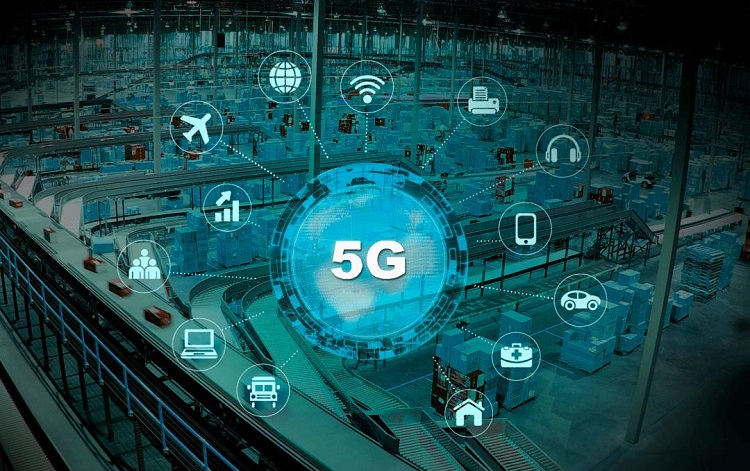As 5G becomes more mainstream, its possibilities for industrial and manufacturing applications seem endless. 5G can support a large number of IoT technologies and is considered a catalyst for the fourth industrial revolution.
5G, Industrial IoT and the Fourth Industrial Revolution
5G will be a driver of change in the commercial and industrial Internet of Things (IIoT) sectors. From autonomous guided vehicles (AGVs) and augmented reality (AR) to smart city infrastructure and industrial automation, 5G can trigger the fourth industrial revolution by fusing smart technologies and manufacturing practices. 5G connectivity will enable humans and machines to achieve breakthrough innovations that were previously the realm of science fiction, such as the effortless synchronization of robots and humans.
Many of these breakthroughs are already happening today, and the rollout of 5G will make them even more common, especially in the Industrial Internet of Things. Experts expect this market to grow from US$68.8 billion in 2019 to US$98.2 billion in 2024, with semiconductors, electronic equipment and cloud computing platforms leading the way. Fundamentally, 5G will have a major impact in the Industrial IoT space because it provides a single network that is flexible enough to handle a wide range of Industrial IoT use cases.
Manufacturers that currently rely on wired connections will eventually need to upgrade to 5G to remain competitive. Of course, if they haven’t harnessed the power of 4G yet, they can start now by optimizing their current network usage and gradually transition to the latest technology. However, 5G’s cost and time-saving advantages, such as increased factory flexibility, improved machine insights and process monitoring, will significantly reduce costs and improve quality and efficiency.

How will 5G revolutionize the industrial Internet of Things?
Through 5G, the Industrial Internet of Things will be able to greatly improve industrial monitoring. For example, when the COVID-19 pandemic hit, many businesses struggled to remotely monitor their on-site systems. With 5G, companies can remotely monitor systems through cameras and manage and control them remotely through cellular routers. This also translates into greater insight, resilience and resilience to unexpected situations such as supply chain disruptions.
5G connectivity can also enable wireless manufacturing and thus wireless industrial automation. While traditional industrial automation is nothing new, its potential is hampered by the need for cables. Robots are limited by the need for cables, and solutions like Wi-Fi cannot provide the bandwidth, range, mobility or quality of service required for industrial control. Additionally, current 4G cellular protocols have latency issues that hinder efficient use.
However, with 5G wireless manufacturing, greater flexibility and agility can be achieved at lower costs. Likewise, 5G increases speeds, reduces latency and enables machines and humans to communicate and collaborate seamlessly. In addition, 5G enables sensors and other devices to consume significantly less power, extending their life cycles and reducing maintenance issues.
Another area where 5G provides tremendous value in the Industrial IoT is enhanced security. The fabric of 4G and 2G/3G connections is integrated, and once the bad guys get in, they can compromise the entire system. In contrast, 5G architecture is service-based, which means there is greater segmentation and isolation. If a hacker gained access to a 5G-enabled system, they would be isolated to an area without access to all services.
Edge computing and 5G
Edge computing and 5G connectivity are two inseparable technologies that will significantly improve application performance and the ability to process large amounts of data in real time. They work together to create a complementary solution. While 5G is ten times faster than 4G, mobile edge computing can further reduce data traffic and reduce latency by processing data closer to the end device. Telecom operators report that, at least in labs, 5G offers network speeds that are 20 times faster than LTE1. In this area, there are still some hurdles before 5G can hit these speeds consistently. Still, 5G’s reliance on edge computing has the potential to deliver faster results.
Potential barriers to 5G and industrial IoT
While 5G will inevitably transform the industrial IoT through clearer visibility, enhanced security, and greater flexibility, manufacturers must still address key barriers to adoption—primarily cost. Many companies have yet to foresee the financial returns from 5G deployment. However, if businesses take the time to analyze how 5G can help them achieve their goals, they will find that 5G is financially feasible. Other obstacles include how to get started with industrial IoT and the fact that 5G network coverage remains limited in many areas.
These are legitimate challenges and not insurmountable. Finding the right partner to provide technical support is a good way to solve many problems of 5G and industrial IoT. RTU interface extension
